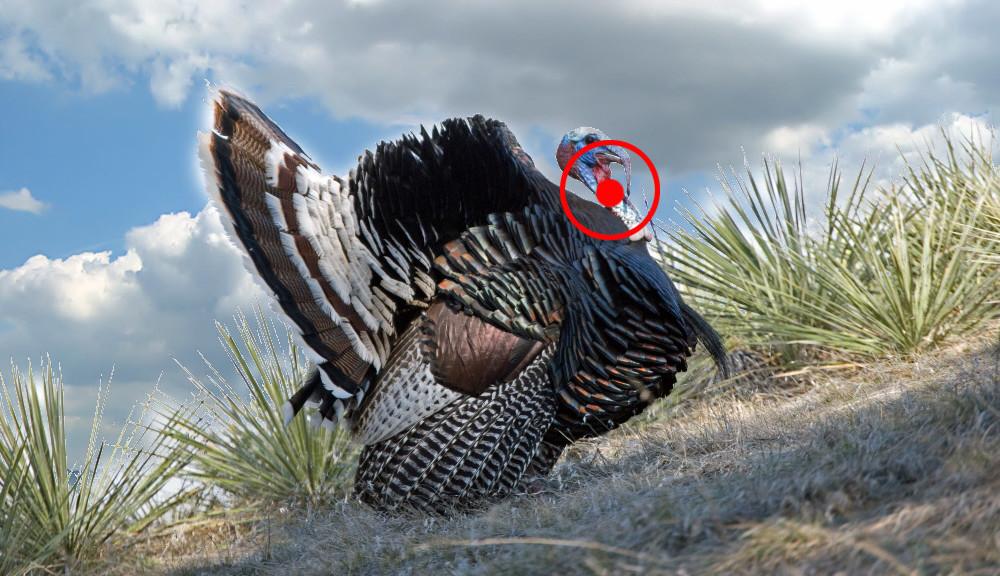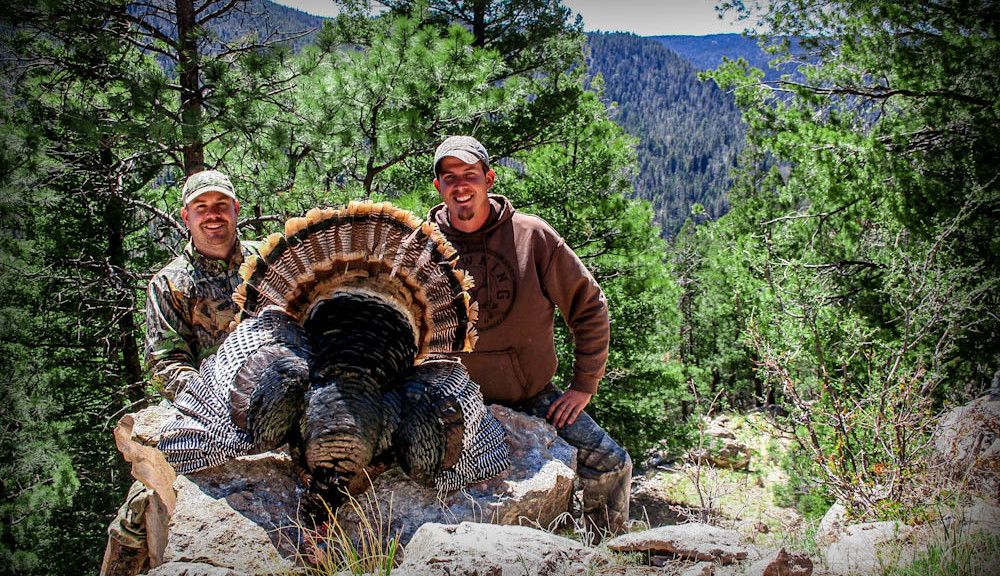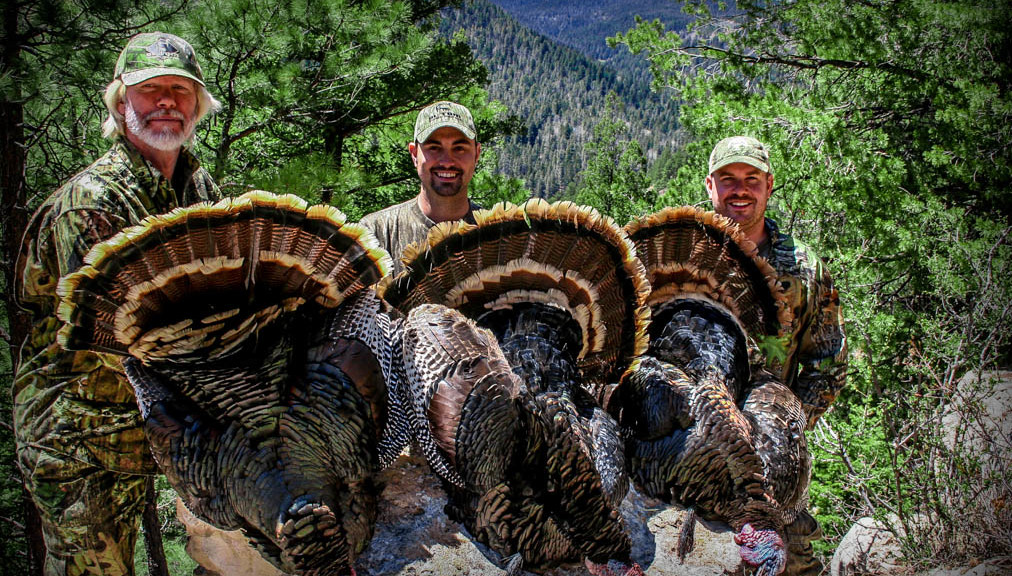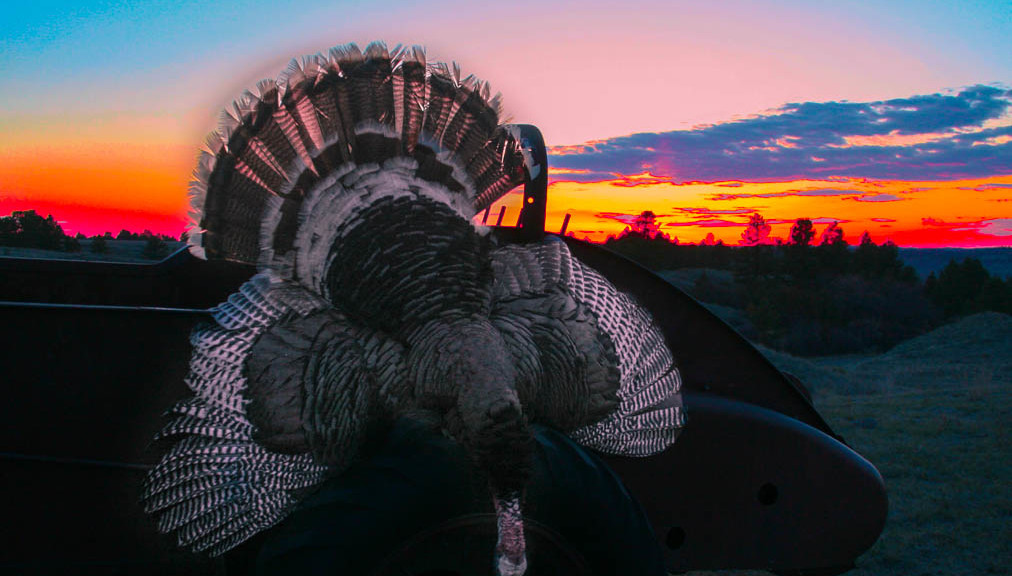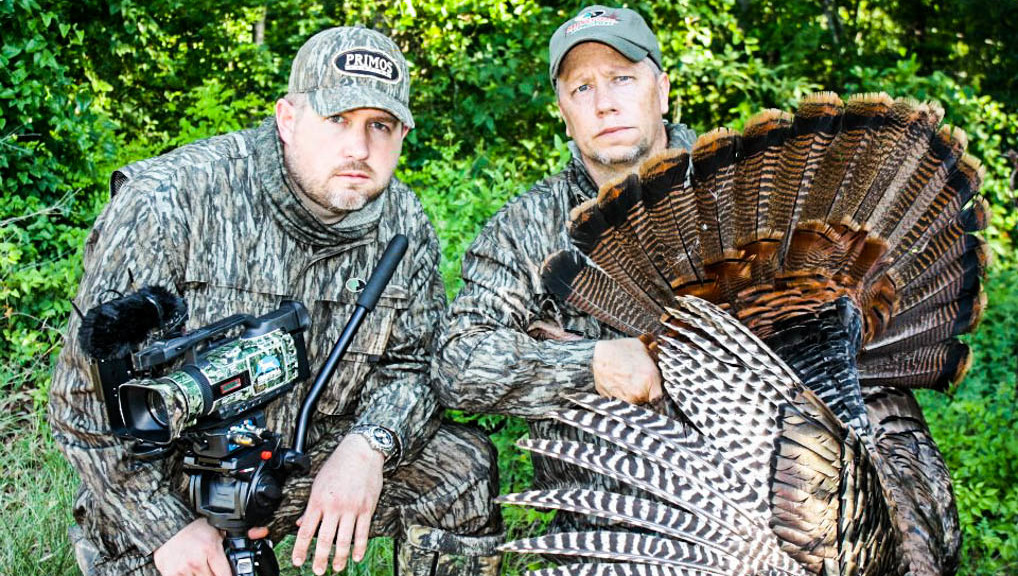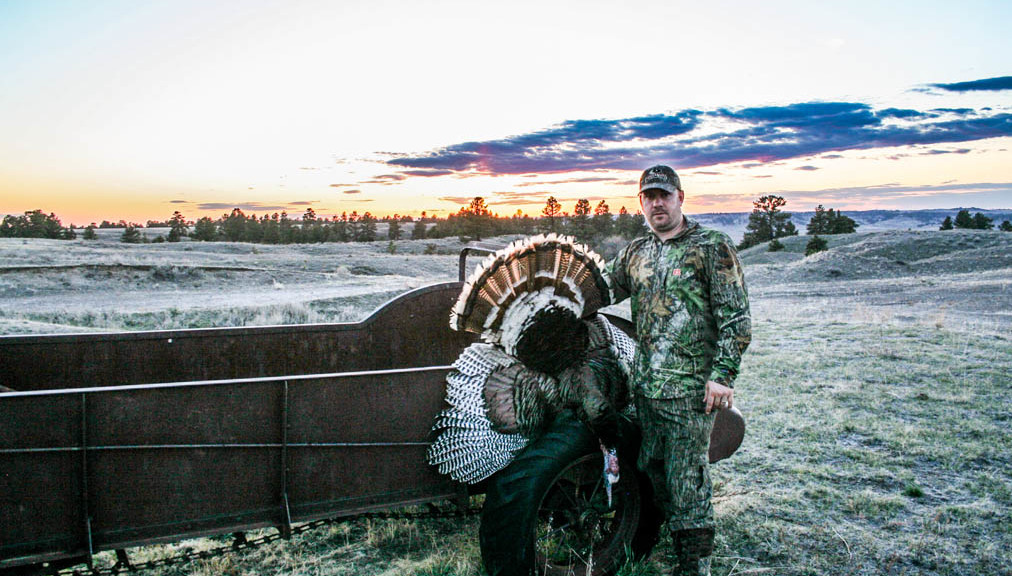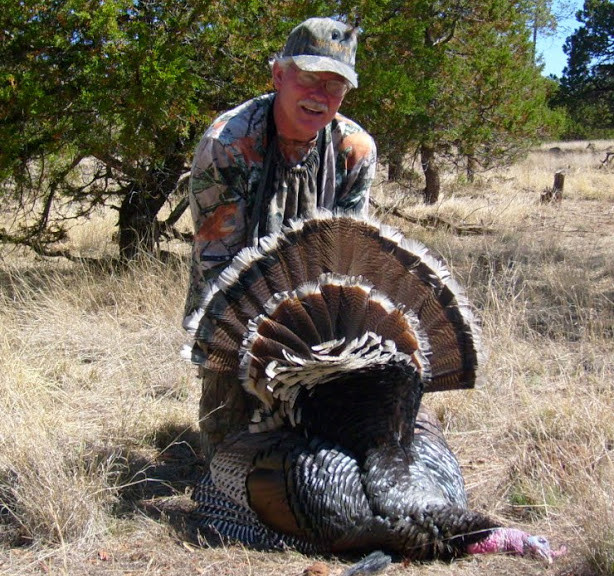For the best sound, always keep your slate, glass, and crystal friction calls conditioned. Slate calls can be conditioned with Scotch Brite pads that can be found at most stores like Walmart or Home Depot. Simply run the Scotch Brite pad back and forth over the call’s surface. Scotch Brite can also be used to clean the tips of your striker – you really don’t want to use sandpaper! Sandpaper can change the shape of the striker’s tip. For glass and crystal calls, I recommend using a conditioning stone like David does in this video, but you can also use drywall sandpaper.
All posts by Grant Carmichael
Scratch Box Turkey Call Tips with Beard Hunter Calls
One of my favorite call makers to visit at events is Russell Beard from Beard Hunter Calls. He make some fine calls! In this video, Russell shows us how to run his scratch box turkey call. The call is easy to use and as you can see in the video, it makes some really nice clucks, purrs and yelps.
How to Shoot a Turkey
If you’re new to turkey hunting, you might be wondering how to shoot a turkey – and make it count! This article focuses on where to shoot a turkey with a shotgun. For the most part, when shooting a turkey with a shotgun, you’re going to aim at the head and/or neck.
Where to shoot the turkey
When turkey hunting with your shotgun, you want to aim at the turkey’s head or neck region. My favorite place to aim is where the waddles meet the feathers on the neck – and maybe a little up from there. Naturally, with the shotgun you will have the shot scattered in a circular pattern around the point you were aiming. If you’re aiming at then neck, your shot will hit the neck and head – and the result will be a clean humane kill.
How far can you shoot a turkey?
Pattern your gun. There’s no room for guess work after you’ve spent hundreds of dollars on camo, guns, and calls only to miss a bird. If that happens, you probably kick yourself the entire way home. Besides, heading out to the range with a few buddies and patterning guns is fun.
Anyway, in the next session, I’ll cover an easy way to pattern your turkey hunting shotgun. You need to be putting a minimum of 78 shot in a 10″ circle. Personally I like to have well over 100. My Remington 870 youth model 20 gauge with a 21″ barrel and an Indian Creek .555 choke shooting Hevi-Shot #7s shoots 120-140s consistently at 40 yards. When I back up to 50 yards, it backs me down to about 90 shot in a 10″ circle. So I consider my effective range with that combination to be 40 to 45 yards.
Before the shot
I’m not going to go in depth on patterning in this article, but before you hit the turkey woods, be sure to pattern your shotgun with the same gun/choke/shell combination you’ll be hunting with. Changing up one factor in the gun/choke/shell combination will result in a different pattern. Sometimes the change will be enough to cause a miss! To pattern your shotgun, follow these steps:
- Buy a brown paper roll from the Home Depot, which is typically found in the paint section. It cost less than $10 and is cheaper than some of the other alternatives
- Mark a dot on the paper to aim at. Using a range finder, step back to 30 yards, and shoot at the dot you marked on the paper. Be sure to write the yardage information and the shotgun shell info on the target.
- Find a piece of cardboard and cut a circle with a 10″ diameter. Locate the most dense pattern on the brown paper and draw your circle around it. Draw a crosshair on the circle to create four sections, and count the holes in each quadrant and total them up.
- Keep in mind, a 10″ circle has 78 square inches. So your target needs to have at least 78 shot in the circle to make 1 shot per square inch.
- Repeat the process with a new sheet of paper, backing up 5 to 10 yards each time until you’re no longer getting at least 78 shot per square inch.
- This should help you identify your effective range. Once you find it, shoot at that distance a few more times to make sure everything is consistent.

Make the shot count!
When you set up on the turkey, be aware of your surroundings. First and foremost, make sure you’ll be shooting in a safe direction! Also consider the following tips before the shot:
- When you setup, make sure you have room to move your gun around and that the barrel is unobstructed. After all, you never know which direction the turkey will choose to come in. If you do have to swing the gun around, you can either wait until the turkey walks behind a tree, or you can just wait until he gets close and SLOWLY move. He’ll see you, but if your movement is slow, he might pop his head up and start to walk away – giving you time to put a bead on him and squeeze the trigger! I prefer to move the gun when he passes behind a tree or bush.
- Make sure you’re not shooting into brush, it will throw off your shot.
- Don’t rush the shot. If you’re looking down the barrel at the bird, its easy to become unnerved and squeeze a round off too early. Wait for the clear shot within your effective range!
- If the bird is walking or strutting, cut with a mouth call. He should stop or come out of strut and lift his head up. When he does… bust him.
- If you shoot right handed, get setup in a direction with the barrel facing slightly right of where you think the turkey will come in. Its easier to swing and aim left than it is right if you’re a right handed shooter.
- Get comfortable. If you’re not comfortable where you’re sitting, you’re more likely to move around and get busted in the process.
- If the pattern on your setup is TIGHT, be sure to take your time especially when the bird is close! Its easy to miss a turkey that is up close!
Here’s my missed turkey from 2012 on a North Georgia public land turkey hunt! I never saw this limb until after the shot. The bird came in from behind.

After the shot
After the shot, you hope to see a dead bird bouncing around like he just ate a load full of #7 Hevi-Shot! Either way, get ready for a second shot. You might have missed or sometimes a bird will flop or lay still, and then get up and run off (happened to a couple of folks I know last year). Regardless, you want to be ready for a second shot if needed. I usually try to get to the bird quickly with the gun in hand. I carry my gun in case he takes off when I get close to him. When you get to him, be careful picking him up – he can spur you good! That’s why most people just step on their head until they quit flopping.
Finally, always remember to keep your gun on safety before and after the shot! Its easy to forget to place the gun on safety during the excitement of the harvest! Stay safe, shoot straight, and let us know how you do!
Thanks to all or our members who share tips on shooting and patterning your shotgun for turkey hunting!
Roosting Turkey in New Mexico
Use this method for roosting turkey in New Mexico and kill more turkeys this Spring! New Mexico is an awesome state to harvest your Merriams turkey for your grand slam! There is lots of public land to hunt turkey, elk and other game. One of the most effective ways to locate merriams turkey in New Mexico is to use a high pitched crow call when roosting them in the evening. You can literally drive the roads boarding public land, stop every 1/4 mile and locate birds for the mornings hunt. Watch this video to see how one of New Mexico’s finest turkey hunters, Ryan Bates, roosts his merriams!
New Mexico Turkey Hunting
The Grand Slam Network crew represented us Georgia turkey hunters with some New Mexico turkey hunting for the 2012 season opener! What a BLAST! We left out of Atlanta, scouted the day before turkey season opened, and started killing merriams opening day! The hunt continued for a few days until we were chased out of NM and back to reality!
The first few days were cold – and WINDY [I’m guessing 30-40mph winds]. The 25 degree mornings started somewhere around 4 or 5am. After downing coffee, packing a water and snacks, groups would start to pull out of camp to the birds roosted the night before. On the windy mornings, it was hard to hear birds on the roost, and success came from skirting the NM mountain ranges calling into cuts before dropping down and over to the next ridge. Birds would seek cover from the wind in the deep cuts with steep banks.
My first bird came from one of these cuts – he came strutting up the cut to the sound of a raspy box call. After they’d gobble, and I knew they were still a little ways out, I’d stick one hand under my backside to provide some relief from the cold – my hands were freezing! Our strategy payed off! The Benelli smoked him and had to chase him down the hill as he flopped. Ryan and I later slid down the slope on our rear [it was too steep to walk down on some parts]. We were able to get most of the footage on film, but unfortunately didn’t get the kill shot!
By the time lunch came around, we had usually walked for miles up and down mountains, shedded camo layers, and were ready to make our way back to camp for food and a nap. BUT of course, we had to stop on the way back to camp and glass the stutters seeking attention from the ladies in the canyons. At least once, several of us made the hour round trip to a cell signal to call back home and provide updates to our families. One day I opted to hunt, what Ryan called the kill’n hour (2pm), which apparently had some truth to it because I landed my second Merriam! I glassed him up a road strutting for some hens, and around the kill’n hour, the hens left Mr. Tom, and he responded to some soft yelps and purrs and came in on a string!
After lunch and a nap, groups would start to talk over the evenings plans, run a few calls, and on some days make some mouth calls from Jim’s stash of latex, frames, and hole tape. By this time, it would be 70 degrees and dropping. We’d make our way back to our evening spots. Bobby came back with an evening bird – a NICE one at that!
For Ryan and I, we’d hunt our evening spots and then break away to roost birds before it got too late. By this time herds of elk piled out of the hills into the pastures. Dinner consisted wild game cooked in a BBQ pit. As the evening progressed, every one would start gearing down by swapping stories of how their day unfolded.
What a blast! We met some great turkey hunters – both LEGENDS – and the newly addicted. I really appreciate everyone’s hospitality! I lucked out by getting to hunt with one of NM’s finest turkey killers, Ryan Bates. The dude flat knows the land, knows how the birds work and where they hangout.
GA GSN boys! [thats just how we roll!] 😀
What a bunch of rough looking dudes…
4 Tips for Capturing Quality Hunting Pics
We spend countless hours and days preparing, driving, scouting, and hunting turkeys. But it’s interesting how once we’ve accomplished our mission how few of us take a few extra minutes to take care of our bird and put forth the effort to capture the moment with quality hunting photos.
After hunting all morning or all day and then killing a bird I’ll admit that often I’m tired and at the moment getting a good photo or finding a good place with a backdrop seems like too much trouble. Looking back I can tell you I’m always glad I did take the time especially when it involved family members and friends. One glance at the photo and the entire memory of the hunt comes back. I’d suggest to everyone reading this that its worth taking a few extra minutes and going through a little extra trouble each time you, a friend, or family member, harvest a turkey, and take quality photos.
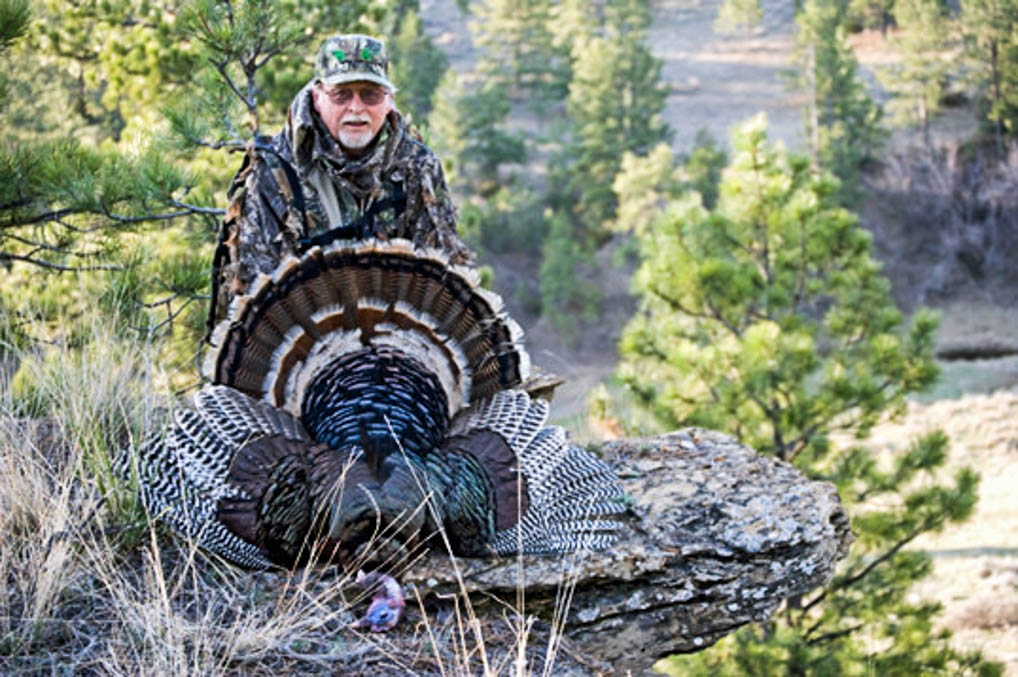
Bird Prep: To get good shots is simple but it starts from the moment you take the bird. For the bird to look good in any shots he has to be fluffed out. If I’m coming straight out of the woods I carry him over the shoulder so that his wings don’t stiffen tight to his body. On a long walk I may tuck him in my vest but I load him carefully and hang him upside down as soon as I get him back. This will allow his wings to be spread out for photos later. If I’m continuing to hunt I use a small piece of rope that I carry to hang the bird upside down from a tree and pick him up on the way out. Don’t just lay him down and don’t just pile him into the back of the truck where his fan will get damaged.
Backdrops: At a minimum you should always take the shot free of clutter. Little things like a camera bag or any odd items will stand out in a negative way in photos. Pay attention to what’s in the background and at least make sure its natural whether it is grass or brush. Avoid the pick up truck and carport or any location where man made objects clash with the photo. Don’t shoot into the sun and ideally use a flash to eliminate shadows. Don’t include a portion of someone else’s bird laying beside yours unless he or she is in it posing with the bird.
Scenic backdrops: I’m not going to say that there are scenic backdrops everywhere we hunt but there’s always a “good’ spot that stands out. Taking a few minutes to drive over and pose with the bird can pay off. Some of the best shots I’ve taken have been out west but there are plenty of places wherever I go. But again, at a minimum, take a moment to find a natural background and surface to photograph your bird.
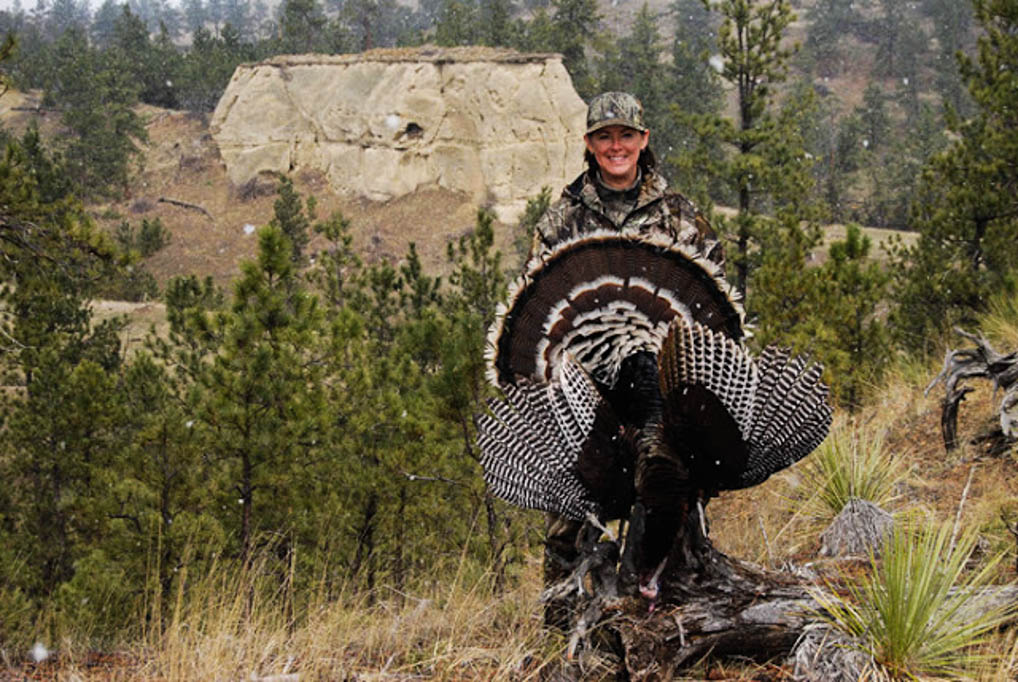
Positioning: One option is to just spread the wings and fan and pose behind the bird. Other options include looking for interesting set ups such as laying the bird over a log, rock formation, fence post, or old farm equipment. Elevating the bird on a piece of firewood may provide a better view. Frame the shot and take several photos both close and with some distance. Take some center and some with the person and bird off to the side.
I’ve seen some great shots from guys here on our forum where they are posing at the mouth of a cave or walking with the bird over their shoulders and across a creek. Some capture the amazing scenic views that come with hunting out west. Some capture the tough brushy Texas terrain and cactus. The bottom line is it takes little effort to get nice shots and it comes down to being creative and working with what you have.
I carry a tripod and often have to use the timer if I’m by myself. Ideally I shoot on the “RAW” setting with the camera on “auto” and then go back and use Photoshop to do the automatic edits. You can get really good shots this way. But even if you don’t do any of the special settings or edits, you can get great shots with today’s cameras. You just have to take a few minutes to do it after the hunt.
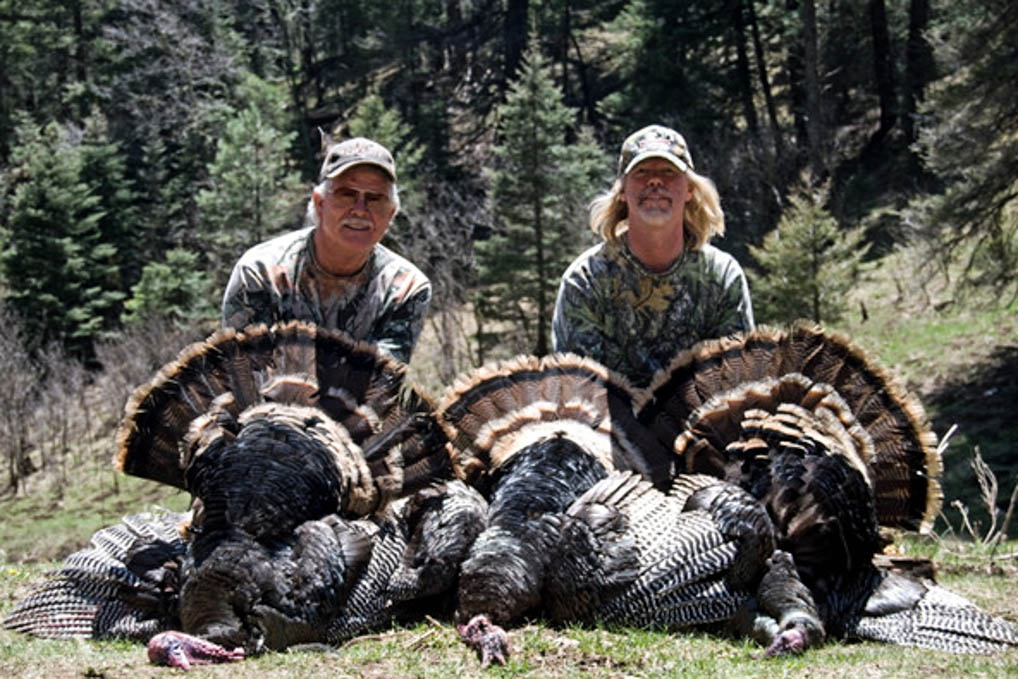
Think about it this way. If you’re getting up at 5:00 in the morning, spending the dollars and time to chase this bird, isn’t it worth a little effort to take the time to capture the end result of the few successful hunts we have each season in a quality way? I believe if you do the memory shared with family members and friends will be better preserved for all involved for the rest of your lives. Use these 4 tips for capturing quality hunting pics.
By Bobby Parks
Grand Slam Network
Ol Tom Field Expert
Mossy Oak Pro Staff
Mouth Call Magic – Scott Ellis
Whether you’re hunting pressured public land turkey and want to rise above the other hunters, or you just want to take your calling to the next level – Mouth Call Magic is the perfect place to start. Scott Ellis, champion turkey caller, takes you through the various calls that every serous hunter needs to master. This isn’t your typical “here is how you yelp” video – Scott does a great job of showing you advanced techniques. After watching this video, you should be a better caller and put more birds on the ground.
Filming Turkey Hunts
I would like to start off by saying that you are either going to love it, or you are going to hate it. You have to have the passion not only in front of the camera but behind the camera as well. Filming turkey hunts takes a lot of time and patience and there will be numerous times in the field where nothing seems to come together, yet there will be days when it does, just like chasing that ole tom around every spring. Sometimes we are rewarded but most times we fail, that goes hand in hand with filming your hunts. I am not saying that the footage you gather will not be lasting memories, it will, but we all strive to get that “kill” on video. You have to be willing to pass up shots because either you or your cameraman was not in the right position. If you have a hard time accepting this, filming may not be your thing. Don’t get discouraged and keep after them. Keep that footage and try and learn where your mistakes happened and improve in those areas. Let’s start off by talking about the equipment needed to begin filming your hunts.
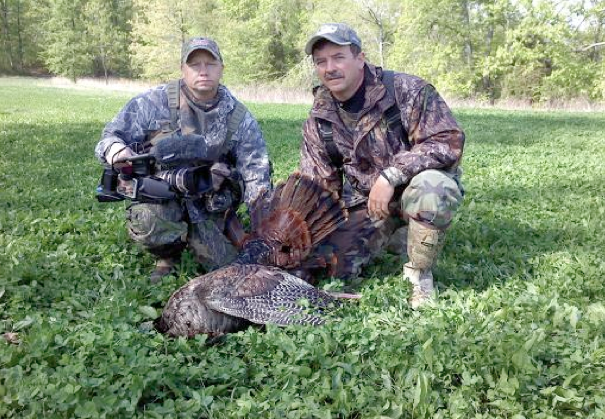
Cameras: There are several models out on the market that make fantastic videos. Choose a camera that fits your budget. Once you get into the filming and decide this is something you want to pursue, then you can upgrade and buy a better camera. Please remember, you get what you pay for. So if your objective is to get footage to share with your friends and family, I would go with a low-end camera. If the footage is to be used for TV shows, websites or for DVD’s, I would suggest going with a high-end camera. The quality of footage you are trying to achieve will be affected by the camera you choose.
Manual Focus: Whatever camera you choose, it needs to have a manual focus. As we all know so well, not every set-up is going to be ideal. By ideal, I mean nothing obstructing the view for the cameraman or the shooter. There are going to be instances where there are limbs, tall grass, branches, etc. in the way. This is where the manual focus comes in. Without it, your camera is going to be focusing on these objects in the foreground and not on the bird you are filming so a manual focus is a must. I always carry pruning shears to eliminate these situations when needed.
Low Light Settings: Another option to consider but not a necessity is low-light settings. This feature will allow you to film during low light conditions like can occur first thing in the morning when a bird flies off the roost and straight into your lap. Depending on the time this happens, you will want this feature in order to capture the footage; otherwise you will get “grainy” footage. While filming turkeys, this is not a feature I would worry too much about. Most of the time, your lighting will be just fine.
Size and weight of the camera is another option to consider. After a day in the field, that camera will get heavy. Personally, I prefer a smaller frame camera; it allows me to be portable and versatile. The maneuverability is much greater as well. It is just like toting a heavy or longer gun into the woods, after a while, it can become uncomfortable. So take that into consideration when choosing a size.
Shotgun Mics: Shotgun mics are an integral component for picking up quality sound such as gobbling and drumming. Cameras with remote mic ports allow you to use this option. Most cameras have decent audio built into them, but in order to pick up those ambient sounds, you will need a shotgun mic. I like to hear those leaves crunching, wings dragging, and gobbles rumbling when a bird is closing in on my set-up. A shotgun mic targets those dynamic sounds.
Wireless Mics: These mics are used for situations when your shooter is separated from the cameraman. It allows the cameraman to hear and pick up audio from the shooter without having to raise his voice or take a chance spooking game. The shooter can instruct the cameraman that a bird is in view allowing him to get the camera on the bird. A shotgun mic needs to still be used in conjunction with the wireless mic set-up. When using a shotgun mic, I would suggest getting a “wind sock” or “wind screen” to slip over the mic. This will reduce the wind noise if it is present.
Digital or Optical Zoom: You may encounter some cameras with digital zoom versus optical zoom. Optical zoom cameras are the ones I prefer. The larger the number, the further you can pick up images in the distance. Optical zoom uses the lens (optics) to bring the subject matter in closer whereas digital zoom enlarges a portion of the image. You may loose image quality with digital zoom cameras.
Tripod and Heads: When filming turkeys, I prefer using a tripod. Without the stabilization, your footage is going to be jerky and unstable. Choosing a good quality tripod will affect your footage along with a good quality fluid head. The smoother your panning’s are, the better images you will be able to capture. The fluid head is a must for smoother footage. I like a tripod that is quick and easy to set up as well. There will be situations where you got to get down and dirty in a hurry. The fumbling around with your equipment can cause you to bump that bird that is coming to your calling. Also, don’t be afraid about trying to conceal your tripod under some camouflage material or such….I have filmed wide-open for many of hunts and have yet busted birds. I am not saying that you can’t get busted, but just be slow with your movements.
Batteries: It is always good to have extra batteries with you at all times when you are in the field. Whenever I am filming, I leave my camera on at all times. I do this because you never know when that bird is going to step out. Since the camera is constantly on, batteries tend to die especially on those colder mornings. A little trick I use on those colder days is to keep my extra batteries in a “coozie” along with hand warmers. This trick usually extends the life of my batteries. You never know when your battery is going to die and you will need that extra one.
Protection: When I say protection, I am referring to camera protection from elements. You never now when you are going to get caught out in the rain while filming. I always carry a grocery bag in my vest to cover my camera during these situations. To be honest, I try to avoid filming when the weather is crappy. Cameras are too expensive. You take a risk in ruining them if you elect to try. There are camera rain covers available through different camera companies and they allow you to film in these conditions, they just cost more than a grocery bag.
Tapes: Be sure to use the same type of tapes in your camera. It is not good practice to change brands. This will cause the heads in your camera to malfunction. I do suggest if you have to change for emergency purposes, always clean the heads. Keep a head-cleaner tape with you at all times. Not necessarily in your vest, but with your camera equipment. Always label your tapes after the hunt. If you don’t, you will be constantly trying to figure it out and it is not good practice to view your footage through your camera.
Camo Your Equipment: Anything that shines or sparkles needs to have camo on it. You know as well as I do about the vision a turkey has. I put camo on my tripod and on my camera. This helps eliminate getting busted while filming. It is not a 100% solution, but it does help.
The Set-up: This can make or break your footage. Set-ups are an important key to your success for acquiring footage as it is for giving that bird a dirt-nap. I try to set up in open terrain, not necessarily wide open but in spots where I think I can get the best footage possible. It is difficult to get good footage if you are set up in thick brush or cover. After you find a spot, give a quick glance around to make sure nothing will hinder your movements with the camera. If there is, take care of it right away. Sometimes you will just have to go with what you got, when you have to hunker down quickly.
Ground blinds are much easier to film out of than being in the open and the turkeys don’t seem to mind where you place them. They allow you to make quick movements within the blind without blowing your cover.
Actual Filming: When filming your hunts, you want your footage to tell a story of that particular hunt. Whenever I get set up, I film the scenery around me by panning from right to left. I film everything because in the end, you can edit out what you don’t like but if you don’t have the footage, you can’t add it. Film the sunrises, the other creatures that are out and about, as well as your shooter walking in to your set up itself……film it all. By doing this, not only will you have the footage but it will give you practice with your camera. All of this footage is what we refer to as B-roll footage and it will help tell your story.
Be Prepared: I try to visualize the shot before it happens and practice moving the camera around to make sure nothing is in my way. I try to anticipate where the bird may come from and be prepared to video those areas without obstructions. I like to set up over the shoulder of my shooter so when the bird walks out, I can capture the whole image in one frame. It allows me to focus in on the bird leaving my shooter somewhat out of focus. This also eliminates having to go back and do cutaways of your shooter getting his gun up and flipping the safety off. If you are filming out of a blind, you can film the shooter doing all of this as well before the shot is actually taken.
One very important part to remember is to take your hands off of the camera when the shot is taken. By the reaction of the shot, you are going to jump a little and you don’t want that in your footage. You want to be focused in on that bird and jumping may cause you to shift off of the bird missing the “kill” shot. To give you a scenario of what I try to capture on a hunt goes like this: Press RECORD, get the shooter seeing the bird or pointing to the bird, zoom in on the bird, come back to the hunter if you are not over his shoulder, follow the bird in, then get tight on the bird before the kill. Go back to the shooter to get his reaction after the kill. Remember to use smooth motion when panning back and forth. Film your shooter walking up to the bird, give a quick interview of how the hunt played out, and show off the fan, beard, and spurs if you like. I like to keep the conclusion of story short and simple. After all of this, I like to film the shooter walking away with the bird over his shoulder.
Like I said, if you forget any of this, you can go back and do your cutaways of the hunter; however it is sometimes tough trying to re-create the excitement of the shooter. It is very important to keep the bird in the center of your frame and stay in focus, especially if the bird goes behind brush or trees. You will actually lead him while he is walking into your set-up. Try not to zoom in and out repetitively and keep your zooming smooth. Here are a few things that I try to avoid in my footage. No cursing, no chewing tobacco (which I am guilty of), no spitting and no alcoholic beverages being consumed. Clean kills are your priorities so if the shot doesn’t present itself, don’t shoot.
I would highly recommend getting someone to help you film. It is hard to get good quality footage doing it alone. Your footage will never be as good by yourself as opposed to someone else filming it for you.
And most importantly, always remember to press “RECORD”.
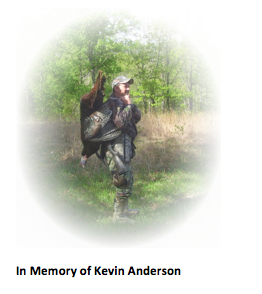
By Roger Petty
Ronnie Smith Outdoors
Pot Call Tips with David Halloran
In this turkey calling tips video with David Halloran, he covers the following pot call tips that will help you call in more turkey this spring:
- How to hold a pot call. Make sure you don’t grip the call too tight.
- Demonstration on how to cut with a pot call
- How to kee kee on a pot friction call by griping the striker tight and using the outer edge of the call surface
- How to purr and cluck on a pot call by letting the striker skip across the surface
The Crystal Mistress’ sister has arrived – the Twisted Sister. She’s a raspy yelping, sharp cutting call that is sure to bring tom in on a rope. The laminate pot combines the stability of thermal treated poplar with the tonal quality of yellow heart. When matched with the crystal striking surface over a slate soundboard, this call becomes a devastating tool in the turkey woods. Each call comes with a dymondwood striker and a purple heart striker.
Jim Bates: Holder of NWTF’s World Record Goulds Turkey
Jim Bates resides in Las Cruces New Mexico and has been involved with the NWTF and with the state of New Mexico’s conservation efforts for many years. I met Jim 3 years ago and I can tell you he is as unselfish and humble as the day is long and it took me a year of knowing him before I even found out about this bird. The Grand Slam Network asked Jim Bates to share his story about the hunt involving his taking of the World Record Goulds turkey. It took some prying on our part as Jim is one of those guys who never wants to appear as though he’s bragging about anything. Well this is something to brag about and fortunately for us, Jim is a very good writer as well as turkey hunter. The following is his story regarding this once in a lifetime hunt.
Bobby Parks
Ocho Barvas by Jim Bates
“Shoot him, Dennis!” I whispered to my hunting companion who sat next to me under the scraggly juniper tree we had chosen for our blind.
“No…you shoot him!”
“Dennis, shoot him…he’s got at least three beards!” I emphasized as the big gobbler walked casually by us five yards away.
“No…he’s your bird, shoot him! Dennis retorted as the distance between us and the bird gradually widened.
“It’s your turn; I shot the last bird yesterday!” I hissed.
“He’s walkin’ off, you better shoot him!” Dennis responded, matter-of-factly.
Such was our animated exchange as we slowly watched the Goulds gobbler walk out of sight up the canyon, and presumably, out of our lives forever.
“I can’t believe you didn’t shoot that bird! Did you see how big he was!…how many beards he had!” I scolded Dennis as we both sat there in utter disbelief, recognizing that we had just bickered our way out of the bird of a lifetime for one of us. Disbelief soon turned to laughter as we both shook our heads and chided each other over what we had just done.
That whole episode and what had transpired on this morning and the two days before, were a result of a series of events caused by our association with the National Wild Turkey Federation. Until five years prior to this adventure, Dennis Daniel and I had never laid eyes on one another, had never spoken, and likely never would have except for our respective positions with the NWTF. You see, at the time Dennis was working out of the NWTF headquarters in Edgefield as the Making Tracks coordinator with the Forest Service, and I was serving an extended term as the New Mexico State chapter president.
The two of us had become acquainted when we met at a NWTF regional biologist’s meeting held in New Mexico’s Lincoln National Forest several years prior. As is generally the case in these situations, our initial conversations had eventually turned to hunting as Dennis and I, along with other attendees at the meeting, discussed the possibilities to be found in the mountains and forests of New Mexico, as well as the respective locales from which each of us had come. In the next several years, Dennis and I would run into each other at NWTF meetings and events on occasion, or find ourselves chatting about NWTF or Forest Service issues via e-mail.
Ultimately, our conversations would invariably lead back to hunting. Dennis and I found we shared common hunting interests, not only with wild turkeys, but also with elk, and soon we found ourselves contemplating hunts for both. The spring of 2005 found us hunting together in Florida for the Osceola subspecies, and again in the fall, when we got together for an elk hunt in New Mexico. During that hunt, we discussed the possibilities of an excursion into Mexico to hunt Gould’s gobblers. I had mentioned to Dennis previously that I had been attempting to make contacts in Mexico to set up some spring hunts, and that a hunt for the spring of ’06 was beginning to look promising.
“Count me in if it comes together”, Dennis said.
“Okay, you’re on my short list” I assured him.
As time went by, the possibilities of a Gould’s hunt became more promising. Numerous obstacles that had looked almost insurmountable at one time or another slowly began to fall by the wayside. One by one, issues and concerns were addressed. Arrangements were made with my contacts to procure the necessary licenses and permits. Access to a property that had Goulds turkeys was obtained. Shotguns for the hunt were gathered up by our Mexican contacts so that we would not have to deal with trying to jump through all of the hoops needed to take our own shotguns. Insurance and registration concerns about taking vehicles into Mexico were explored. By the end of March, I felt fairly confident that our “do it yourself” Goulds hunt was going to come together. From that point forward, Dennis and I referred to our hunt as “the great adventure”.
And so, on May 3rd, I picked up Dennis at the El Paso International Airport, both of us anxious to see how things were going to work out. After gathering up food and provisions for our journey south, and confirming plans with the other two individuals who were to be part of our group, we went to bed that evening believing that we had covered all the bases and were ready to go.
At dawn on May 4th, the four of us departed Las Cruces, Dennis and I in my 4X4 pickup and the others in theirs. The first bump in the road occurred when we tried to cross the border. Dennis and I had all of our paperwork in order, and had no problem getting the necessary permits for ourselves and my vehicle. However, our companions, it turned out, did not have all of their “ducks in a row” in terms of paperwork on their truck, even though we had discussed and cussed the details “ad nauseum” for weeks before the hunt. To make a long story short, the two of us were allowed into Mexico, and the other two were turned back. I insisted that they try to get things straightened out and try to come down to meet us later but after all was said and done, they could not.
We were scheduled to meet our Mexican contacts before noon, so Dennis and I headed south toward Chihuahua City. After a three-hour drive, we met Jeremy, the owner of the property we were to hunt, at an intersection of two highways, and after waiting for the arrival of our two assigned guides, Pedro and Carlos, we headed west towards the Sierra Madres. By mid-afternoon, we had made our way through one mountain range, across a high plain, and into the next mountain range, which comprised the ranch we were to hunt, and which supposedly held an abundance of our quarry.
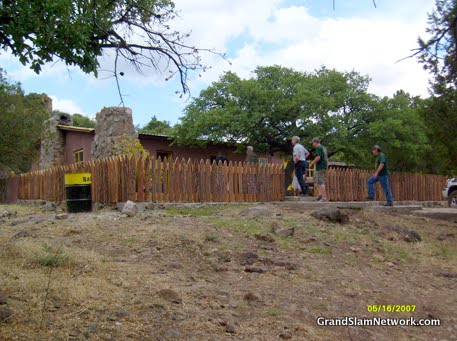
Upon arrival at our destination, a neat little Mexican ranch nestled in a small canyon at the base of the mountain range, we were shown our quarters and given a brief rundown on the facility and the hunt. I had been told, in my initial contacts with the outfitter, that the ranch was about 9800 acres in size. After questioning Jeremy about the size of the property, his first response was “who told you that?” Expecting “ranch shrinkage” to occur at this point in time, imagine our delight when he informed us that his place was almost 50,000 acres! And not only that, but the turkeys, of which he assured us there were many, had not been hunted in at least five years that he knew of!
So here we were, the two of us, hunting a huge Mexican ranch on which the current generation of Gould’s turkeys had never been harassed by hunters! We looked at each other with sly smiles which essentially conveyed the meaning: “What a Deal!!” Needless to say, our optimism for the possibilities for “our adventure” was sky-high!
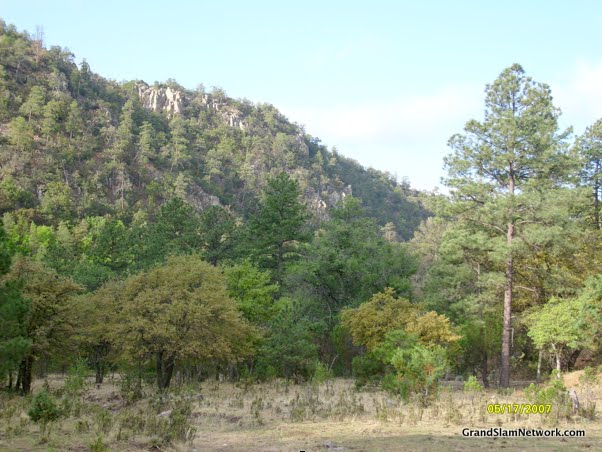
That afternoon, that optimism was rewarded when our hosts drove us higher into the rugged mountains to a rock dam on the edge of a high mesa. We parked the truck and eased our way to within a couple hundred yards of the dam, and there, in a sun-drenched clearing, were perhaps two dozen Gould’s turkeys, gobblers and hens, going about their business. As we sat and watched the birds—we had chosen not to take guns on this first afternoon reconnaissance mission—-we marveled at the size of the strutting gobblers and their glistening white fans and rump feathers. There were at least eight mature toms in this procession, and even though it was late afternoon when gobblers are generally prone to be somewhat hush-mouthed, these birds were whoopin’ it up. Gobbles rang out with regularity, and Dennis and I just looked at each other and gleamed. It was beginning to look more and more like this adventure was going to be a doozy!
That evening, over a mesquite-grilled steak dinner, we discussed our plans for the next morning with our hosts. We would return to the rock dam on the mesa before daylight and head for the first gobbles, wherever they might be. After inspecting the five shotguns that our hosts had rounded up, all 12 gauges of various persuasions and chokes, we settled on a Beretta semi-auto and a Remington pump as our weapons of choice for the next morning.
At first light, we found ourselves standing in the pre-dawn darkness in the clearing next to the dam. We were somewhat surprised when it was nearly full daylight before the first gobbler sounded off in a deep canyon immediately to the south of the dam. We hiked to the edge of the canyon, and soon we could see him strutting on a shale rockslide near the canyon bottom 500 yards away. We briefly contemplated attempting to find a way off of the precipice and into the chasm, but eventually came to our senses and decided instead to bide our time in the vicinity of the dam. Finally, after another half-hour, we were rewarded with distant gobbling on the mesa a few hundred yards to the west. Our entourage of four moved quickly in the direction of the gobbler, which, we were fairly certain, was now on the ground and readying himself for the morning’s courtships.
We moved through the scattered oaks, junipers, pinons, and manzanita until we thought we were within striking distance. Dennis and our two assistants crawled up under the low branches of a small juniper tree while I hurriedly looked for a suitable spot to try to film the action with my video camera. After all of us were satisfied with the set-up, Dennis enticed the bird with a soft series of yelps. From that direction came a responding gobble. All was well. A couple minutes later Dennis once again called to the gobbler but this time received no response in return.
I was busily trying to pan the area to get some set-up footage for the hunt. As I panned to the left and out in front of us, something looked out of place. Closer inspection revealed a lone mature gobbler, standing at the base of a pinon tree forty yards distant. The bird had quietly moved in and was now surveying the situation. Soon he ballooned into full strut, and began what would turn out to be an excruciatingly long performance within a five yard radius of that pinon tree. Not knowing how the Beretta would perform at that distance, Dennis chose to bide his time and hope that the big gobbler would eventually venture closer. Such was not the case however, as the bird had set up shop and was not about to sully his reputation by advancing further toward this apparently irreverent hen.
As time slowly slipped by, I was beginning to wonder if we had reached an impasse with the bird. He would not take a step closer than about forty yards, and try as we might, we could not entice him to come further. At about the forty-five minute mark of what was now turning into quite an ordeal, since both of my legs had fallen asleep and my back was screaming for some Doan’s pills, I thought I heard faint drumming from behind us. As the sound grew closer and more distinct, it soon was apparent that another gobbler was approaching from our backside.
This gobbler’s approach was slow and calculated as well, but soon I could see the bird swinging around the far side of the tree under which Dennis and our two amigos sat, and I swung the camera around just as the bird passed by them at about ten yards. As I filmed, the tom headed directly toward the other gobbler, and at fifteen yards, Dennis raised his gun and ended the suspense of this opening act of our hunt.
His first Gould’s gobbler under his belt, which incidentally completed his royal slam, Dennis was all smiles as we admired the beautiful tom. After the obligatory back-slapping, picture-taking, and story re-hashing, we continued on with the hunt in an effort to find another bird for me, and although we heard a few more gobblers and tried a couple of set-ups, the big birds were content to go about their morning without indulging us.
Later that afternoon, after eating a late breakfast at the ranch and taking care of the processing of Dennis’ gobbler, we decided to once again head back to the rock dam to try to find me a bird. It was basically a repeat of the first afternoon in that we approached the dam and found several turkeys, including at least four adult toms, hanging out there. Moving as close as we could without being detected, I got out in front of our quartet and called to the birds.
The brush was fairly thick in the area of our set-up, which ultimately led to me not noticing the first pair of gobblers that eased by to our left at about forty yards. As they moved away from us, I chastised myself for not being attentive enough. However, Dennis motioned to me that another gobbler was approaching on the far side of a juniper tree that obscured my vision. I scooted slightly to my left to see around the tree, and immediately could see not one, but two gobblers slinking through the brush at twenty yards, skirting to my left.
They were not aware of our presence, and a couple of soft yelps on a mouth call, brought them out into the open at fifteen yards. Both were good, mature gobblers, and I shouldered the same Beretta that Dennis had used to dispatch his bird that morning and placed the bead on the head of what I thought was the larger of the two. At the shot, the birds (yes, that’s right… birds) startled and began running for cover. In a momentary state of shock over having missed the tom at no more than fifteen yards, I barely recovered in time to roll him with a second shot before he could dart into the brush.
I was relieved that I had managed to cleanly kill the bird with the second shot, which had I not done would surely have meant an endless barrage of needling from Dennis, not to mention the two guides. Any such badgering, I’m sure, would have continued non-stop for the remainder of the trip (and in Dennis’ case, for the remainder of our association). We gathered up the bird and proceeded with another round of congratulations, pictures, and hunt summaries.
Needless to say, Dennis and I were in good spirits that evening, especially after our successful negotiation of an agreement with our compadres to hunt for a second bird apiece. With a plan in place to hunt a new area of the ranch on the second day, we enjoyed the evening, along with our new friends, over grilled country ribs and a number of cold beverages.
The next morning found us in the situation described at the beginning of this article. Pedro and Carlos had taken us to another known roosting area in the bottom of one of the major canyons on the ranch and at daybreak we had several gobblers within earshot. The first bird to come to our calls was the big old boy that we inexplicably, and apparently with a full dose of turkey hunter’s irrationality, let walk away unscathed.
After mutual admonishment for what we had done, we continued to call from the same location for another hour. Two other mature gobblers came to investigate during that time, but neither was exceptional, or at least not in the same class as the first bird. We could hear hens yelping, and occasional gobbling, up the canyon bottom we were in, so after concluding that we had milked our stand for as much action as it was going to give us, we got up and gathered up Pedro and Carlos from the brush behind us. By this time, we had made the two of them the designated hunt videographers, and they were enjoying trying to get good video footage of these two American buffoons who had just let “guajolote macho grande” (REALLY big gobbler) walk off.
Easing up the canyon bottom toward the still-very-vocal group of Gould’s turkeys, we approached as closely as we thought we should. There were two good-sized Chihuahuan pine trees nearby, and we agreed that we would just stand against the two of them and call to the birds to see what developed. Our two movie-makers ducked into the brush behind us as we sent forth a few inquiring yelps. Immediately, at least two hens on the slope above us responded, and soon we were in a four-way conversation with them. They would respond to every call we made, although the gobblers that were presumably with them would not, and we were finding ourselves quite entertained by the whole exchange, so much so that we failed to notice a big lone gobbler coming down the canyon bottom toward us. Fortunately, Carlos saw him, and whispered to let us know of his approach.
By the time Dennis and I noticed the bird, he was forty yards out and on a steady march to locate these two new noisy hens. As he closed the distance, I heard Dennis whisper, “Jim, I think it’s that same gobbler!”
“Are you sure?” I asked, not yet being able to see the bird’s chest well.
“Yeah, it’s him….shoot him!”
“YOU shoot him!” I whispered emphatically, while at the same time thinking to myself, “Oh no, here we go again”.
“No, I want YOU to shoot him!”
“Dennis, we’re not going to let that bird walk away again…SHOOT HIM!” I demanded, the gobbler by now walking past us at fifteen yards, and obviously becoming concerned about the two talking tree trunks.
“I don’t have a shell in my gun!” Dennis whispered with a smirk, content that this probably intentional oversight would finally settle the issue. “YOU are going to have to shoot him!”
Realizing that Dennis had played the final trump card, and that it was time to throw in the towel, I raised the shotgun, brought it up and around the tree I was behind in one motion, settled on the gobbler’s head, and ended the discussion once and for all.
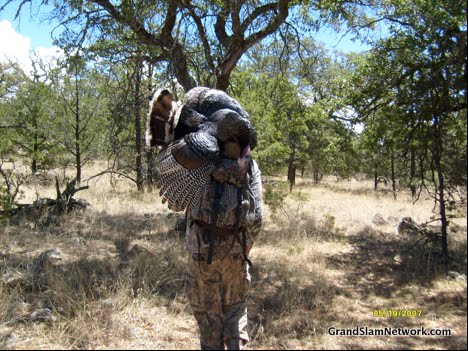
Whoops and hollers followed, as the four of us ran to the gobbler, all anxious to see just what this grand bird had to show us. When things had finally settled down, I gently turned the bird over and fumbled through his breast feathers to sort out the assortment of “modified feathers” which adorned his chest. The first count was five beards, the second came up with seven, and the final tally, after I had settled down enough to actually think rationally and do a systematic inspection, was eight.
“Ocho barvas!! Ocho barvas!!” Pedro and Carlos exclaimed in unison, recounting the total in Spanish. Before us lay the granddaddy of all Gould’s gobblers. Looking down at his legs, we were equally delighted that he had good spurs, by Gould’s standards, on both legs, somewhat of a rarity in itself. All in all, he was, without a doubt, the bird of a lifetime…. and to think that the two of us had almost let him walk off TWICE!!
That evening, two hours before dark, we again returned to the rock dam in an attempt to fill Dennis’ second tag. As was the case the previous two afternoons, there were several gobblers in the area, and Dennis tagged his second gobbler, another exceptional bird, if only having ONE ten-inch beard, after a classic calling session that brought the bird, and another, in strutting and gobbling.
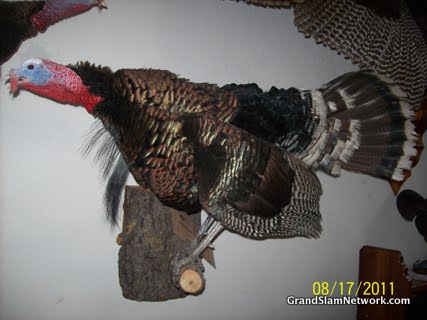
All told, the two of us had taken four outstanding Gould’s gobblers in two days, had an absolute blast, and had made a number of new friends from a different nation in the process. For two would-be strangers from opposite ends of the country, who had only met as a result of a mutual association with the National Wild Turkey Federation, the adventure did indeed turn out to be BIG!!
FOOTNOTE: After all was said and done, I was curious to see just how well Ocho Barvas would stand up against other Gould’s gobblers in the NWTF record book. After reviewing the record book and the scoring system, I was surprised to find that he is the new atypical record for Gould’s scoring 139.00 and besting the old record by somewhere in the vicinity of 23 points! He has eight beards with 52.5” of total beard length (longest 11 1/8”), has spurs measuring an average of ¾” each, and weighed an even 19 lbs.
If you go…
As turkey hunting increases in popularity across the country, more and more hunters are becoming interested in traveling to Mexico to hunt the fifth of the North American subspecies, the Gould’s, in an effort to complete their “royal slam”. Although we went to great lengths to try to avoid any pitfalls with our trip, we did encounter some stumbling blocks along the way. From my experience, it appears that the rules and regulations are subject to interpretation, depending on what port of entry is used to cross back and forth into Mexico. Hunters who plan hunting trips into Mexico should be aware of the following:
1) Make sure you have acquired a passport (a birth certificate and drivers license or I.D. will no longer be acceptable beginning in 2008), and make sure you get your passport properly stamped when entering and exiting Mexico. Not getting the proper stamps on your passport when you depart Mexico could result in complications if you were to try to re-enter at a later time. There will generally be a nominal fee associated with your entry into Mexico for your hunt.
2) If you take your own vehicle into Mexico, make sure you arrange for supplemental insurance on it for the time you will be down there (you can contact your insurance agent for information on this—the cost for five days of full coverage for my pick-up was about $75.00 American). You also must have the vehicle registration (current) with you and proof of insurance coverage on the vehicle. You will be issued a vehicle permit at the Mexican port of entry. (The cost for this permit for our five day stay was about $30.00). You must relinquish this permit when you leave the country.
3) If your vehicle has a lien holder, you should contact them and ask for a letter of permission to take the vehicle into Mexico. Although I was not asked to present this document, I have been told that it is best to have it available just in case, as you may be denied entry if you don’t have one and are asked to show it.
4) While in Mexico, you most likely will be able to pay for things with American dollars, and in many cases this will be preferred. Make sure you take small denominations with you to pay for incidentals like food, gas, and tolls and become familiar with the currency exchange rate between Mexican pesos and American dollars. Many vendors/stores will take American credit cards, as well, but don’t depend on paying for things with them.
5) Make sure the Mexican outfitter you deal with can provide you with all of the licenses, permits, and documents that you will need (and don’t assume that he knows about everything you are supposed to have—make sure you review the documentation needed and go over it with him). You must have a signed contract with the outfitter that outlines the details of the hunt and the ranch you are hunting. You also must have an official certificate with state seal (UMA hunting permit) from the Mexican state you are hunting that verifies you are hunting on a property that has filed for and met all of the hunt management criteria as required by the state. The outfitter should provide you with a numbered tag for each bird you kill (cintillo) and the tag number should be recorded on the contract. You must attach a validated, numbered tag to each bird you harvest. We were told by the field officers at U.S. Customs that it is a common problem to have hunters coming back from Mexico without all of the licensing and proper documentation that is needed.
6) Unless you have gone through all of the registration and licensing process to take your own guns for your hunt, make sure you do not have any firearms or ammunition with you when you enter Mexico. Having any kind of firearm or ammunition that is not properly licensed and registered will most likely bring a sudden and unpleasant end to your Mexican adventure and will probably result in you and your hunting party ending up in a Mexican jail. If you are relying on your Mexican outfitter to provide shotguns for your hunt, be certain that you and he have ironed-out all of those details.
7) At this time, you may bring the meat and of the turkeys you harvest back into the U.S. if you desire (We gave all of the meat from our birds to the ranch hands and our guides). Also, you may bring the capes of the birds and they should be packaged in a sealable container or bag (we put ours inside heavy duty trash bags and then put the bags in an ice chest. All capes are required to be sent to a certified taxidermist to go through a fumigation/delousing process before the bird can be mounted. You should obtain a list of the certified taxidermists from U.S. Customs (or your hunt booking agent, if you have one) prior to your trip, contact that taxidermist to confirm your intent to use his services for the process, and obtain the required form (Report of Entry/Shipment of Restricted Animal Products) for this. This document, which indicates where the birds will be sent to be processed, must be presented to U.S. Customs when you cross back into the United States.
8) Along with the above, a declaration form (Declaration of Importation of Wildlife) must be filled out and presented to Customs, as well. This document lists the numbers and the species that you are declaring to bring back across the border.
Also, regarding taking your own vehicle down for your hunt, you should be prepared for extremely rough travel on terrible roads through very rugged country. A four-wheel-drive vehicle is advised, preferably with high clearance, and don’t go down there without at least two spare tires, some “flat fix” cans, and a plug kit. And make sure your vehicle is in good running condition!
Finally, the people down in Mexico in general are very friendly, even though you may not be able to communicate fully with them. If you go down there with the proper attitude of respect for the Mexican culture and the people, you will undoubtedly have a wonderful experience and come back having made some very good friends.
By Jim Bates
